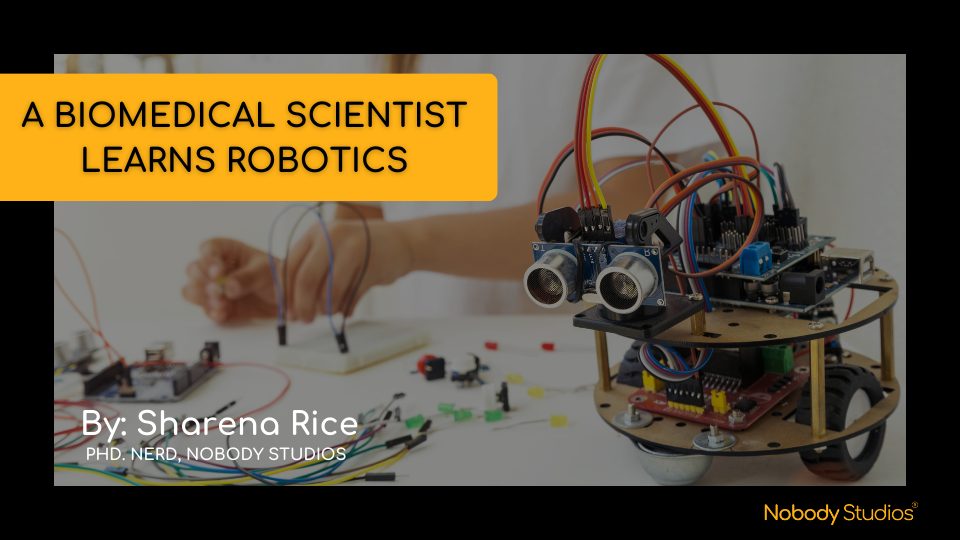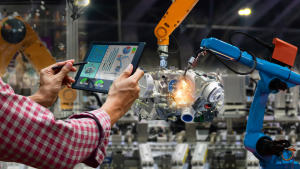
People with a biological science background often ask how I got into robotics. After all, I did a Bachelor’s in biochemistry at California Lutheran University, a small liberal arts college which only offered one robotics course and never took a robotics course. I enjoyed playing with wires and building circuits with magnets, motors, and lights as a child, but diverged from these interests as I became more fascinated by how the mind and brain worked.
It was finals week in the last semester of senior year. In a break of studying for exams, I lamented to Carla de Lira and Maxine Nelson that my ten-year-old self would be so sad if she knew I was not doing anything with robots! They suggested I talk with Dr. Reinhart, the one robotics professor our college had.
Dr. Reinhart allowed me to borrow a robot over the next semester, a Boe-Bot with an Arduino stamp. I named it “Junior” because it was so absurd to have a non-biological organism with such a name. I programmed Junior to say “Hello world!”, count to ten, to blink their LED light on and off. Junior learned so fast, faster than it took to run immunostains. I knew I had to keep working with robots in some capacity.
During my first research rotation as a neuroscience graduate student at the University of Michigan, I was in Dan Leventhal’s lab wiring operant conditioning boxes with lights and cameras for skilled reach tasks in rats. I received good guidance from Matt Gaidica, an older student in the lab with a strong electrical engineering background. Matt encouraged me to build elegant systems, even when the neatness of the wiring could not be seen on the surface. I used some of this knowledge in developing and debugging systems for mouse navigation behaviors with Vaughn Hetrick in Omar Ahmed’s lab, where I did my dissertation. While serving as Co-Founder and Chief Scientific Officer at Intvo, I thought through computer vision sensor systems as challenges in robotics, often taking the perspective of how the system was processing incoming information to make sense of pedestrians. Now, I take the perspectives of various machines with humans in the loop in thinking through systems at Nobody Studios, Valence Vibrations, and the stealth medical technology company I work at. To research sensory systems neuroscience or physiology, or to develop technologies that involve the nervous system, knowing how to build robots is useful.

Suggestions for learning robotics if you are new to the field:
- Collect an official Arduino robotics kit and a multimeter. Many robotics kits do not seem to come with multimeters, but it is useful as an electronics diagnostic tool. This is especially the case for a complete beginner.
- Follow the instructions precisely. Start building circuits on the breadboard and programming. Programming is a layer of control structure of electronics, but it is important to know how electrical circuits work, as well as how to program.
- Test electrical properties with the multimeter to measure from different parts of the circuit and get a feel for how resistance, power, and grounds work after building each circuit and when different commands are being implemented.
- After successfully building a robotics project by the book, go into creative dimensions by programming the robot to say and do delightful things.
- Take lots of pictures and videos in the process to avoid what I call “robo-clutter”. That way, it is ok to take the electronics apart because you would have a record of things you made, then use many of the same components to create new projects. You do not need a bunch of robotics kits unless there are specific components for other robots you need to build!
- Do all of this in the spirit of playfulness, considering the dimension of reality that the robot is interpreting if it is a system interacting with the world and whether its output would be the appropriate thing to do in the situation.
- It can be good to go ahead and just build a robot or electronic control system you come up with yourself. But it is often also useful to draw diagrams with a pencil and paper to refine the idea before building. Sometimes, the most efficient course of action is to machine a part with a mill at a makerspace rather than to 3D print a part. Sometimes, it is better to build the shape of a device out of cardboard as a rough draft to test its interface. The way to bring the idea into the world often comes down to what tools you have available and what way solutions are best implemented.
- Talk with people inside and outside of engineering about robotics. Robotics projects can stall if you hit a wall and cannot figure out whether the problem is rooted in the programming or in the physical machine. Learning how to find and solve these problems is a skill to develop by thinking through the steps an engineer would take to debug the system. Communicating with engineers can help in learning to think like an engineer. Sometimes too, the best ideas and analogies come from unexpected places.
No one field, whether biomedical sciences nor robotics, will solve the problems in health and wellness on their own. The silos must be busted, the disciplines integrated seamlessly, to bring forth innovations. With some fundamental knowledge on how things work, it becomes far easier to create advances and to imagine what may be possible within the constraints of reality, then to be part of building an emerging new reality.
Best wishes for getting into the circuit AND with the program.
Happy wiring!
ABOUT THE AUTHOR
Sharena Rice, PhD
Nerd, Nobody Studios
A systems neuroscientist, cybernetician, and storyteller. Her positively contagious personality and perspective on life make her a highly sought-after partner and collaborator.



